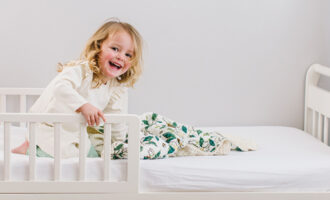Getting ready to go to sleep should be a time of peace and relaxation. It’s all about shutting down for the night, switching off your busy and worn-out processing systems and giving them a well-deserved rest. But what happens when you can’t switch those systems off, or getting ready for bed brings with it a horde of uncomfortable assaults on your senses?
Sensory processing disorder affects a wide range of people, and it can make navigating the landscape of everyday living a challenge. Let’s look at what sensory processing disorder does, the relationship it has with our sleep habits, and how we can address it for a healthier sleep.
What is sensory processing disorder?
Sensory processing disorder — sometimes called SPD, sensory modulation disorder, or sensory integration disorder — is when the brain has difficulty regulating information it receives through the senses. This means that you might become very uncomfortable with certain physical sensations, that you have difficulty with noisy environments, or experience pain or discomfort in very brightly lit spaces. Any of the physical senses can be affected by sensory processing disorder, and it can manifest in different people in different ways.
In addition to the classic five senses, sensory processing disorder can present itself as proprioception, which is awareness of your own body, vestibular awareness, or spatial orientation, and interoception, which is an awareness of your own internal workings. These can manifest as heightened sensitivity to crowds, or an increased or decreased response to pleasure and pain.
Who is affected by sensory processing disorder?
Sensory processing disorder is most commonly associated with children with developmental disabilities such as autism, but it can occur in people of any age. It’s commonly seen alongside adult autism and anxiety.
Sensory processing disorder can be difficult to pinpoint because it’s not currently a standardized medical diagnosis. It can be even more elusive in adults because we’re so used to adjusting ourselves to fit into our social environments, and we often shrug off our sensitivities as being “just tired”, “just hungry”, “just a bit off today”, and don’t take the time to really look inwards at our relationship with the world around us. Like many developmental disorders, sensory processing disorder represents a spectrum of people with varying levels of sensitivity.
How sensory processing disorder affects our sleep
Sensory processing disorder affects our ability to fall asleep in a number of ways, especially if we’re not consciously aware of it. These can vary widely from person to person, depending on which sense or senses they have difficulty with.
Several studies have shown that there’s a direct correlation between sensory processing disorder and our sleep patterns. When we suffer from a heightened sensory awareness of our environment, it can take much longer for us to get to sleep — if we sleep at all — and our sleep can be erratic and not as healthy for our bodies as it should be. Plus, the reactions triggered by SPD can influence the type and amount of hormones our body releases, such as cortisol and melatonin, and these can have a hugely adverse impact on our ability to get a good night’s sleep.
Here are a few of the ways our senses can affect our ability to sleep.
Hearing
Trying to sleep in a noisy environment is something many people can identify with. For those with sensory processing disorder, it’s multiplied a hundredfold. You might hear a dripping faucet as if it were a gunshot, the distant hum of traffic may feel like it’s driving over your skin, or voices from the apartment next door can feel as though they were right beside you.
Sight
In general, sensitive sight at bedtime manifests as perception of light: too much of it or not enough. Some people with sensory processing disorder might not be able to fall asleep if there’s even a thread of light in the room; others might feel equally uncomfortable in complete pitch blackness. Usually people with SPD will have a happy balance on the spectrum of light and dark that works best for them, and they’ll try to maintain it consistently each night.
Smell
When we’re living with or near other people, external smells can be distracting. You may not be able to sleep if you can smell cigarette smoke coming from nearby, the smell of your dinner lingering in the air, or the smell of toothpaste on your partner’s breath. You might find that you sleep easiest in a completely neutral-smelling environment; or, there might be certain smells such as fabric softener or a beloved perfume that help relax you and make you feel safer as you fall asleep.
Touch
Touch is one of the most commonly manifested sensory processing disorders. This can manifest as a need to sleep with a specific fabric, an extreme discomfort with scratchy or low-quality fabrics, an inability to sleep in clothes that are too tight or too loose, or the need for a room to be a certain temperature. People with sensitivity to touch may often need the feeling of blankets even when it’s warm out, so they might need to sleep with fans or air conditioners to accommodate.
Taste
People with a heightened sensitivity to taste will usually need to fall asleep with a neutral palate; having the taste of their evening meal or their toothpaste lingering can be distracting enough to inhibit their ability to fall asleep. If they’re ill and find that their sense of taste is affected, this may also lead to a discomfort that interferes with sleep.
How to help sleep easier with sensory processing disorder
If you or your child suffers from sensory processing disorder, a big part of your action plan is going to be figuring out exactly what’s causing the sensitivity. This is made even more complicated by the fact that these negative stimuli might not always be the same from one night to another. However, by examining your surroundings and taking stock of the way your body and mind are reacting, you can begin to pinpoint what sort of senses are being targeted and how best to accommodate them.
Managing sensory processing disorder as an adult
Fighting sensory processing disorder means having a heightened sense of self-awareness. If you’re having trouble falling asleep, try checking in with each of your senses and asking your body how it feels. Is it too light, or too dark? Too quiet, or too loud? Do you enjoy the feeling of your bedding and sleepwear against your skin, or is it uncomfortable? Try and isolate not only what senses are in distress, but also which ones are at their most relaxed. This will give you some tools to work within creating your perfect sleep environment. Writing your sensations down in a journal may help with this.
Managing sensory processing disorder for a child
If your child is struggling with sensory processing disorder, you’ll have to work together as a team to understand the best way to help them fall asleep. Depending on how old your child is and how easily they can communicate, this may require some detective work. Pay close attention to their reactions as you get them dressed, as you brush their teeth, to any sounds that might be coming from outside, to their blankets and other bedding. It will take some trial and error, but together you’ll be able to find their most comfortable and healthiest sleeping environment. You can also ask your pediatrician if there are any medications or supplements they might recommend to balance your child’s hormones and ease them into a better sleep.
Self-awareness is the key to managing sensory processing disorder
As you can see, there’s no one-size-fits-all answer to fighting sensory processing disorder, since it can look different on everyone. Every adult and child will have a different way of experiencing the world and different needs for their sleep environment. With a little bit of patience and exploration, you can learn how to manage sensory perceptions and create the perfect sleep space that’s right for you or your child.
Did you like it?4.7/5 (22)





